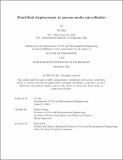Fluid-fluid displacement in porous-media microfluidics
Author(s)
Qiu, Yu
DownloadThesis PDF (45.20Mb)
Advisor
Juanes, Ruben
Terms of use
Metadata
Show full item recordAbstract
Immiscible fluid-fluid displacement under geometric confinement is a key physical process in large-scale subsurface energy technologies such as geologic carbon sequestration and in small-scale microfluidic techniques. Research over the past few decades has provided improved understanding of the fluid-fluid displacement patterns on the macroscopic scale, which range from compact displacement to fractal pattern. Many questions remain, however, regarding how the macroscopic displacement patterns are controlled by the microscale interactions between the fluid interface and the solid surface in systems under geometric confinement like microfluidic devices and porous media. This fluid-solid interaction—exacerbated by the roughness inherent to all natural and engineered surfaces—introduces a large energy dissipation near the solid boundary that challenges our ability to interpret laboratory experiments and develop mathematical models. In Part I of this Thesis, we study the motion of a fluid-fluid interface at the scale of a single capillary through mathematical modeling and laboratory experiments. We first develop a phase-field model to simulate two-phase flow with moving contact lines in the partial wetting regime. We construct a self-consistent formulation of fluid-solid surface energy which allows prescribing arbitrary static contact angles. We then propose a formulation to account for nonequilibrium conditions near the contact line and demonstrate the ability of our model to simulate dynamic configurations, from spontaneous imbibition to wetting transition and interface pinch-off. We then experimentally study the shape of a moving interface in a capillary tube prewetted with the invading liquid. For viscously favorable displacements (when the invading fluid is more viscous than the defending fluid), we find a universal behavior of the dynamic contact angle—a macroscopic descriptor of interface shape—which increases monotonically with capillary number. In contrast, for viscously unfavorable displacements, we observe a sharp wetting transition where the dynamic contact angle shoots to 180 over a narrow range of flow rates. Above the transition, a trailing film of viscous defending fluid is left behind the displacement front and the invading fluid propagates along the tube center as a finger. We rationalize the emergence of this sharp, trailing-film type of wetting transition by means of a minimal-ingredients hydrodynamic theory that exhibits bifurcated solutions. In Part II of this Thesis, we investigate the role of surface roughness on twophase displacements. We do so in a microfluidic device with a precisely controlled structured surface as an analogue for a rough fracture. In the drainage regime, we show that the roughness induces two types of liquid films entrained on the solid surfaces behind the displacement front: the classical Bretherton “thick film”, and a new type of “thin film” that is confined within the roughness. Each type of liquid film is characterized by distinct stability criteria and dewetting dynamics. In the imbibition regime, we show that surface roughness promotes that the wetting liquid preferentially advances within the roughness layer. The formation of a leading film stabilizes the displacement front as the flow rate increases, which would otherwise— that is, in a smooth confinement—become fractal. In summary, our work sheds light on the microscale physics and macroscopic pattern formation in rough confinement that may control long-term mixing and reactivity in geological systems and lab-on-a-chip applications.
Date issued
2024-09Department
Massachusetts Institute of Technology. Department of Civil and Environmental EngineeringPublisher
Massachusetts Institute of Technology